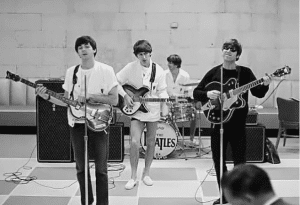10 Classic Rock Bands That Became More Successful With A New Member

via @João Solimeo | YouTube
Lineup changes in classic rock bands are often make-or-break moments. The decision to add a new member can be a gamble, with no guarantees of success or failure. Sometimes, it works out in ways no one could have predicted.
For many bands, these changes happen after a major loss or a clash of egos. Whether due to the death of a bandmate or friction between members, the outcome can dramatically alter a band’s trajectory.
But in some cases, a fresh addition brings new energy, ideas, and a renewed sense of purpose, propelling the group to even greater heights. Here are 10 classic rock bands that thrived after welcoming a new member.
AC/DC
AC/DC’s story highlights the power of a band’s resolve in the face of loss. After the tragic death of Bon Scott in 1980, the band was left with a massive void to fill. In just five months, Angus and Malcolm Young were back in the studio, determined to keep their momentum alive.
Enter Brian Johnson, whose powerful voice became the new driving force behind AC/DC’s sound. His addition marked the beginning of a new era for the band, and the iconic album Back in Black was born.
Despite the tough transition, AC/DC’s raw energy and mission to rock never faltered. The result? They became even bigger than before, with Brian Johnson solidifying his place as one of the most memorable voices in rock history.
Deep Purple
Deep Purple’s lineup has been a whirlwind of changes over the years, with members constantly coming and going. Since forming in 1968, the band saw a revolving door of vocalists, including Rod Evans, Ian Gillan, David Coverdale, and Joe Lynn Turner, each leaving their mark on the band’s sound.
Despite the constant shifts, Deep Purple found stability in 1992 when they reunited with their most iconic lineup. Ian Gillan, the voice behind some of their greatest hits, returned to lead the band once again, creating a sense of consistency that had eluded them for decades.
Gillan’s return marked a new chapter for Deep Purple, reinforcing his legacy as the band’s most emblematic vocalist. His presence also harkened back to the glory days, particularly Machine Head (1972), which gave the world timeless classics like “Smoke on the Water” and “Highway Star.”
Van Halen
Van Halen’s journey is a fascinating tale of lineup changes and musical evolution. The band first achieved massive success with David Lee Roth as their frontman, cementing their place in rock history. However, after Roth’s departure in 1985, the band was faced with the challenge of replacing him.
Enter Sammy Hagar, whose arrival brought a new chapter for Van Halen. Under Hagar’s leadership, the band experienced a period of immense success, often referred to as “Van Hagar.” This era even outshone Roth’s in terms of commercial success, with some fans debating which period was the band’s peak.
Despite the differences in style and dynamics between the two vocalists, both eras of Van Halen left an indelible mark on rock music. The band’s ability to adapt and thrive with each new member only solidified their legendary status.
Black Sabbath
Replacing Ozzy Osbourne in Black Sabbath seemed like an impossible task. Known for his unique charisma and presence, Ozzy was the face of the band. His vocal style, while not technically perfect, became synonymous with Sabbath’s heavy sound and success.
Enter Ronnie James Dio, one of heavy metal’s most powerful voices, who took over in 1979. Dio brought a different energy and vocal range, steering the band through a period of renewed glory. His time with Sabbath from 1979 to 1982 produced some of the band’s most revered work, including Heaven and Hell.
Dio’s impact was so profound that even during his brief return in 1991 and 1992, the band reached new heights. His voice brought a level of intensity and melody that Sabbath hadn’t achieved with Ozzy, proving that sometimes, a change can elevate a band to even greater success.
Genesis
Genesis experienced a unique transformation when Peter Gabriel left the band in 1975. Rather than bringing in a new member, it was drummer Phil Collins who stepped up to fill Gabriel’s shoes. This was a pivotal decision that would reshape the band’s sound and future.
Under Collins’ leadership, Genesis gradually shifted away from their progressive rock roots. The band embraced a more commercial direction, with pop and rock elements dominating their new material. This change marked a significant turning point in their career.
Phil Collins didn’t just lead Genesis to new heights; his solo success in the ’80s and ’90s further cemented his place as a music icon. His versatility and commercial appeal made him one of the era’s most celebrated musicians, influencing the band’s evolution and mainstream success.
Journey
Journey’s early years were marked by Gregg Rolie as the lead vocalist, but it was the arrival of Steve Perry that truly transformed the band. Perry brought a new energy and vocal style that helped define their sound.
With Perry at the helm, Journey began to embrace a more polished, radio-friendly approach. This shift played a crucial role in their rise to mainstream success, leading to some of their biggest hits.
The addition of Steve Perry proved to be a game-changer for Journey, elevating them to international fame. His powerful voice and charisma helped the band secure a massive commercial breakthrough, making them one of the most iconic rock bands of the ’80s.
Iron Maiden
Iron Maiden’s early years were marked by lineup changes, starting with their first frontman, Paul Day. He was quickly replaced by Paul Di’Anno, whose more rebellious style fit the band’s rough, early sound but also led to some self-destructive tendencies within the group.
However, it was the arrival of Bruce Dickinson that truly set Iron Maiden on a path to greatness. Dickinson’s powerful vocals and commanding stage presence injected a new level of energy into the band.
With Dickinson’s debut album, The Number of the Beast, Iron Maiden achieved a major breakthrough. The album soared to the top of the UK Albums chart, marking a new era of commercial success and solidifying their place in heavy metal history.
Pantera
Pantera underwent a major transformation when Phil Anselmo replaced Terry Glaze as the band’s vocalist. Anselmo’s arrival marked a shift towards a heavier, more aggressive sound that set the stage for their future success.
His first album with the band, Power Metal, highlighted this new direction. The album showcased a raw, powerful style that would become Pantera’s signature and helped them carve out their place in the metal scene.
The shift paid off, with Power Metal achieving gold status in the UK and platinum status in the US. Anselmo’s influence played a key role in propelling Pantera to international fame, solidifying their legacy as one of the most influential metal bands of the era.
Pink Floyd
Pink Floyd’s transformation began when Syd Barrett left the band due to mental health issues, leaving a void in their creative core. His departure was a turning point, pushing the band to explore new musical horizons.
With the addition of guitarist David Gilmour, the band’s sound evolved significantly. Gilmour’s smooth, emotive guitar playing became central to their music, while both he and Roger Waters shared vocal duties, further diversifying their sound.
This shift in lineup and direction culminated in the release of The Dark Side of the Moon. The album marked their commercial breakthrough, becoming one of the best-selling albums of all time and solidifying Pink Floyd’s place as one of the most innovative and influential rock bands in history.
Small Faces
When Rod Stewart and Ronnie Wood joined Small Faces, the band underwent a major transformation. The addition of these two talented musicians marked the beginning of a new chapter for the band, who decided to drop “Small” from their name, simply becoming “Faces.”
This change brought a new energy to the band’s sound, with Stewart’s distinctive voice and Wood’s guitar skills elevating their music. Faces embraced a more rock-oriented, gritty style that resonated with a wider audience.
The lineup shift paid off, propelling Faces into commercial success. They became one of the leading rock bands of the early ’70s, with hits like “Stay With Me” and a lasting impact on the music scene, solidifying their place in rock history.





















